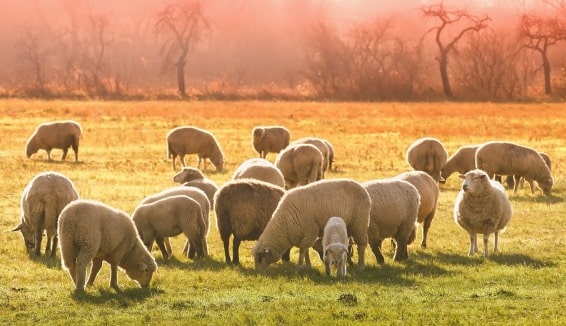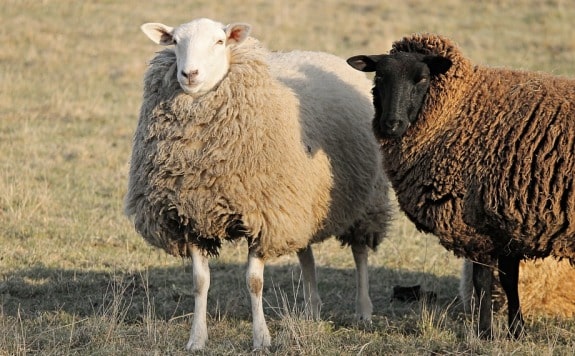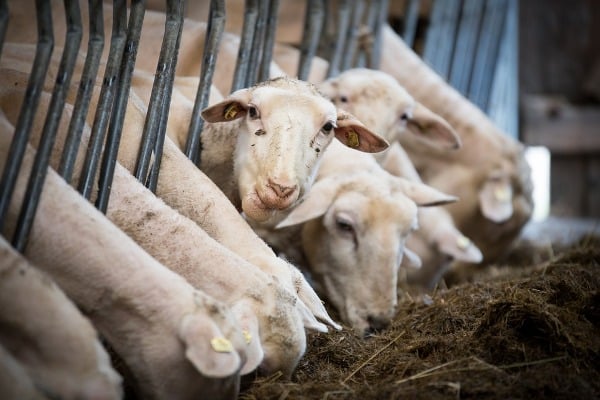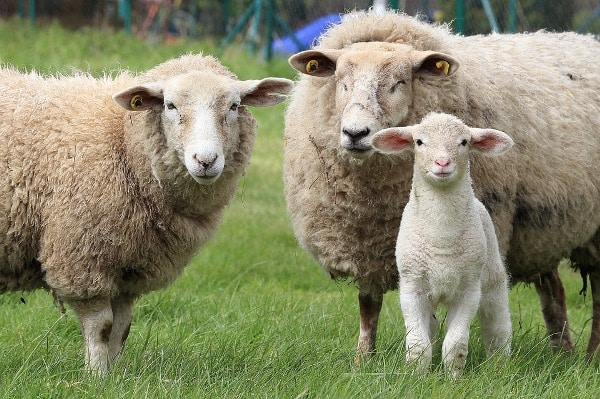Sheep Farming In India:
SHEEP FARMING IN INDIA – INTRODUCTION:
The farming of sheep has been considered as a business opportunity and is being followed since ancient time. It’s been a profession to the people all over the world. Sheep are used for multiple purposes like for its wool, meat, milk, skin and manure. The sheep are commercially reared for the wool and meat, but they are rarely raised for the milk. It is also an essential component for an agrarian economy, particularly desert, semi-desert and mountain areas of the country. It helps as a source of income to the herders.

Livestock systems have both the positive and negative effects on the natural resources like public, health, social equity and also the growth of the economy. The share of livestock farming to the GDP is 33% and it is increasing gradually. The sheep farming is profitable and we get returns in a very short interval. The sheep farming can be done either as a large-scale and small-scale business. Our country is considered to have an average of 42-45 varieties of sheep breeds. They are capable to survive in the prolonged period of drought and semi starved conditions. They are less exposed to extreme climate and parasites. The skin has a unique fiber quality, which protects the sheep from hot sun, winter and rain.
SHEEP FARMING IN INDIA – FEATURES OF A SHEEP:
- The sheep has thick skin and its body is completely covered with fuller coat, which is the source of wool to us. The sheep has an upper lip with a division. The division is called as the philtrum. The sheep’s tail is predominantly short.
- The sheep can’t interbreed with other to produce the fertile offspring.
- Adult male sheep is called as Ram and the female sheep is called as the Ewe. The young one is called as lamb.
SHEEP FARMING IN INDIA – VARIOUS SHEEP BREEDS AND THEIR CHARECTERISTICS:
Based on various climatic conditions and regions there are different types of sheep found in India. These all are categorized into four divisions:
SHEEP FARMING IN INDIA – Northern Region Breeds:
The states of Jammu & Kashmir, Himachal Pradesh and the mountain areas of Uttar Pradesh are the main regions of these breeds..
GADDI:
- The Gaddi breed is named as Bhadarwah. The breed is native to Kishtwar and Bhadarwah Tehsils.
- They are medium in size, White in color and tanned brown or black. The male is horned but the female has only 10-15% of horns. The fleece is white and brown hair on the face.
- The wool is fine and shimmering, the average yield of wool is 1.13 kg per sheep, and they are trimmed thrice a year. These clipped or trimmed materials are sent to Amritsar market and Dhariwal mills. An undercoat material is used in manufacturing the highest quality Kullu shawls and blankets.
GAROLE:
- The Garole breed is native to West Bengal.
- These are small in size, used for its meat and play a vital role in the economic status of the herders.
- This breed is seen in the district of south 24 paragon of West Bengal near the Sunder bans region.
- They are compact and small head with a square body, medium ears and a short thin tail. Their predominant color is gray and white. These breeds are horned.
- They breed has two lambing peaks in a year in the months between December to February and August to September.
GUREZ:
- The Gurez breed is found in the district of Bandipore.
- They are pink in color, their ears are large and leafy, and tail is short and medium in the length.
- The fleece is mostly covered on the forehead, belly and legs of the sheep.
- The wool is clipped in the month of the March and it is in the yellow color.
- The wool is again clipped in the month of September and the wool is then in a golden yellow color
BHAKARWAL:
- The Bhakarwal breed name is derived from the nomadic people of the region. The Bhakarwal breed is native from the PriPanjal ranges of Jammu in the winter and they shift to Kashmir valley in the summer season.
- The rams are horned and ewes are polled, ears are long and dropping and the tail is thin and small in size. They weigh between 29-36 kg, and ewes weigh 55 kg.
- The wool is used for making carpets.
- They are clipped three times in a year. The yield of the wool is 1-1.5 kg.
POONCHI:
- The Poonchi breed is native of the Rajouri district of Jammu region of Jammu and Kashmir.
- This breed is similar to the Gaddi breed, but this is lighter than the Gaddi breed in weight.
- The breed is predominantly white in color, the face is spotted varying in brown to light black, ears are medium to long in size, tail with short and thin, the body size and legs are short.
- The weight of the adult ram is 35-40 kg and the ewe weight is 25-30 kg. The wool is of medium quality is mostly white in color. The sheep wool is clipped from the sheep body thrice a year and the annual yield is 0.9-1.3 g per year. The wool is greasy. The length of fiber ranges between 15-18 cm and the diameter of the fiber is 22-30 µ.
CHANGTHANGI:
- The Changthangi breed is widely white in color and some other sheep would be gray and brown colors.
- The body and legs of the sheep are small; they have a strong body and powerful legs. Ears are small and they are pointed outwards. The horns are also large for some of them and turn inwards, outwards and upwards which form a semicircular ring.
- The weight of a live buck is 20 kg and doe is 20 kg.
- The first kidding average age is 20 months. Once a year kidding is considered normal.
KARNAH:
- The Karnah breed is found in a mountain tehsil of Kurpwara which is a district in North Kashmir.
- These are large size animals. The ram has a prominent nose and large curved horns.
- The wool is generally white in color. These are clipped twice a year, in the spring and autumn which produces 1-1.5 kg wool per year from a sheep. The length of fiber is 12-15 cm. The average diameter of the fiber is 29-32 µ.
RAMPUR BUSHAIR:
- The Rampur Bushair breed is found in the districts of Himachal Pradesh and Uttar Pradesh like Simla, Nahan, Bilaspur, Solan, Nainital, Dehradun, Risahikaesh and Chakrota.
- These are medium sized sheep, they are white, brown, black and tan in color and the ears are long and drooping. The face is convex and has a typical Roman nose.
- The ram is horned and female sheep are polled. The wool from the sheep is of medium quality and density. The legs, belly and the face are devoid of wool.
SHEEP FARMING IN INDIA – North Western Region Breeds:
The states where we find some of the below mentioned breeds are Punjab, Haryana, Rajasthan, Gujarat and some of the regions in Uttar Pradesh and Madhya Pradesh. These regions are most famous for the production of carpet.
SONADI:
- The Sonadi breed is the native of the Mewar region of Rajasthan and also found in the districts of Banswara, Udaipur, Dungarpur and Chittaurgarh; these are also extended to the northern districts of Gujarat.
- Laapdi and Bhagli are the local names of the Sonadi breed.
- They have long flat drooping ears, they are fair in color, and these are smaller to Malpura with long legs and light brown face.
PUNGAL:
- The Pungal breed originated from the pungal tehsil in the district of Bikaner.
- But the pure species of this breed are found in the North Western border districts.
- They are white in color and fairly built; this breed has a black color face, with small strips in light brown color above the eyes and lower jaws. The neck color is black. Their ears are short. The male and female breeds are polled; the tail is short or medium and is thin.
- The fleece is of medium quality but not very dense. The proper breeding process improves the wool quality.
PATANWADI:
- The Patanwadi breed is also called as desi kutchi. These are also found in the regions of Saurashtra and Kutch in Gujarat and the areas of Patna.
- These are also found in the northern and western regions of Gujarat.
- This breed sheep has a large body, long legs, typical nose and long tubular ears.
NALI:
- The Nali breed sheep are well adapted to the arid and semi-arid regions of Rajasthan and Haryana.
- The breed is largely found and seen in the Uttar Pradesh also.
- The Nali sheep has a compact head, large and leaved ears, short legs and forehead is completely covered with wool. The body color of sheep is yellow white. Both male and female sheep have polled horns.
- The wool is clipped in the month of March and September, the yield is in between 2.5-3.5 kg per year
- The weight of a matured ram is 35-40 kg per ram and weight of the ewe is 25-30 kg per
MUZAFFARNAGRI:
- The breed Muzaffarnagri is also named as the Bulandshahri. The native areas of this breed are Muzaffarnagar, Bulandshahri, Saharanpur, Meerut these are the districts of the western Uttar Pradesh and some are the parts of the Delhi and Haryana.
- These breed animals are large in size, slightly convex face lines. The face and body are white and some of the parts are brown or black the ears are also in black color.
- The breed is horned. The tail is extremely long.
- The yield of wool per sheep is 600 g -1 kg.
- The weight of the ram in this breed is 50 kg and the ewe weight is 40 kg.
MARWARI:
- The Marwari breed originated in the districts of Western Rajasthan. The districts where it is abundantly found are Jodhpur, Jalore, Nagaur, Pali, Sirohi and Barmer.
- They even migrate to the remote districts of Madhya Pradesh and also migrate to northern parts of the Maharashtra.
- The sheep of this breed are white in color and has multi-mixer composition of hair, they have long legs, black face and the tail are short but pointed.
- The yield from this breed is 0.90-1.81 kg per sheep.
SHEEP FARMING IN INDIA – Southern Peninsular Regions Breeds:
The regions where these breeds are found in the southern peninsula are Andhra Pradesh, Maharashtra, Karnataka, Kerala and Tamil Nadu. The breeds that are available in these regions are Nellore, Nilgiri, Bellary, Coimbatore, Ramanadhapuram-white, Deccani, and Hassan.
NELLORE:
- The Nellore breed originated and is distributed in the districts of Andhra Pradesh, Nellore, Prakasam, and Ongole.
- They are tall, the rams are horned and the ewes are polled, the ears are long and drooping.
- The weight of ram is 36 kg and the ewe weight is 28 kg.
- The Nellore breed is the tallest sheep breed found in India. It has long hair and face.
NILGIRI:
- The Nilgiri breed is famous from the 19th century, it has originated from cross- breeding and it is native to Coimbatore.
- These are distributed in the district of Neelagiri in Tamil Nadu.
- This breed is of medium weight, white in color with spots on their body and face. The ears are broad and drooped.
- The male sheep are horned and the female are not horned.
- The ram and the ewe both weigh 31 kg.
BELLARY:
- These breeds are found in south region of river Tungabhadra called as Bellary breed and the north region Tungabhadra called Deccani breed.
- The breed Bellary is distributed in the Bellary district of Karnataka.
- They are white in color and also there are some various color combinations in this breed, ears are medium long, flat and drooping, the tail is short, thin and lengthened.
- The yield from this breed is 600 g per animal.
- The ram weight of the Bellary breed sheep is 43 kg and the ewe weight of the Bellary breed sheep is 32 kg.
COIMBATORE:
- It is a native of Coimbatore, a district in Tamil Nadu.
- The Coimbatore breed is also called as Kurumbai. These are found in the districts of Madurai and Coimbatore of Tamil Nadu and also the borders of Tamil Nadu and Kerala.
- This breed of sheep is medium in size, white in color with black spots on the body, Ears are medium sized and are directed down and upwards and the tail is small and thin.
- The Male sheep are horned and female ones are polled.
- The yield from the sheep of this breed is 730 g of wool per animal.
- The weight of the ram is 24-26 kg and the ewe weight is 21 kg.
RAMANADHAPURAM – WHITE:
- The Ramanadhapuram-white breed is native to Tiruneveli district of Tamil Nadu. The breed is distributed in the districts of Ramanadhapuram, Sivagangai and Virudhunagar.
- The breed is medium in size, white in color, ears are medium and directed outwards and downwards and the legs are small, skinny and delicate.
- The male sheep have twisted horns and the female have polled horns.
- The ram weight is 31 kg and the ewe weight is 23 kg.
DECCANI:
- The breed Deccani is spread all over the central peninsular region. This is the cross-breed of sheep from Andhra Pradesh and Tamil Nadu.
- The Deccani breed is small in size; fleece of the sheep is gray and black in color.
- The yield of the wool per animal is 4.54 kg.
- The quality of wool is low graded.
- It is used in the manufacturing the Kambals (blankets).
HASSAN:
- The breed Hassan is native to Karnataka state.
- They are small in size, white in color and have light black and brown color spots on the body, the ears are medium in size and drooping.
- The male and female are horned and polled.
- The fleece of the sheep is white in color.
SHEEP FARMING IN INDIA – Eastern Region Breeds:
The breeds found in the states of Bihar, West Bengal, Assam, Orissa and other eastern regions of the India. The breeds are Tibetan, Balangri, Ganjam, Bonpala and Chhotanagapuri.
SHEEP FARMING IN INDIA – TIBETAN:
- The breed Tibetan is found in the states of Arunachal Pradesh, Northern Sikkim and Kameng district of Arunachal Pradesh.
- This breed sheep are medium in size, with white and black spots on the body. The male and female sheep are horned. The nose has a convex line; ears are small, broad and drooping.
- The fleece is thick and fine. The wool is completely extracted from belly, legs and face.
SHEEP FARMING IN INDIA – BALANGRI:
- This breed is native to Balangir, Sambalpur and Sundargarh districts of Odisha.
- The breed is white in color, medium in size with some mixed colors of fleece on the body, ears are small and stumpy.
- The rams and ewes are polled, the tail is medium long and thin.
- The maximum wool is clipped from the legs and belly of the sheep.
SHEEP FARMING IN INDIA – GANJAM:
- The districts where we find the breeds are Ganjam, Phulbani, Koraput and some parts of the Puri.
- They are medium in size, body in brown color with white spots on the face and body; ears are of medium size and drooped. The tail is medium and thin.
- The male and female are also polled.
- The fleece is short it can’t be sheared.
SHEEP FARMING IN INDIA – BONPALA:
- This breed is native to Southern Sikkim.
- They are tall in height, leggy. The fleece color ranges completely white to black, ears are small and medium, the tail is small and thin.
- The male ram and female ewe are horned.
- The fleece is extracted from the legs and belly, the fleece is hairy.
SHEEP FARMING IN INDIA – CHHOTANAGAPURI:
- The Chhotanagapuri breed is mostly found in Ranchi, Chhotanagapur, Jharkhand, Palamnum and some other districts of Bihar and Bankura district of West Bengal.
- They are small in size, light in weight, light gray and brown in color, the ears are parallel to the head, and the tail is short and thin.
- The male and female sheep are polled.
- The fleece is hairy and the wool is not clipped.
SHEEP FARMING IN INDIA- ADVANTAGES:

- The capital for this business in the initial stage is very low.
- The cost of the labor in the sheep farming is low.
- As the sheep in the farm reproduce frequently there is an increase in the cattle strength, which ultimately increases cattle farming business.
- There no specific fodder required to the sheep. As they eat any plant.
- Sheep survive by eating low-quality grass and they produce high-quality wool and meat.
- Products like Wool, Meat and Milk are obtained from the sheep as products.
- They don’t need more space. We can raise the sheep with other livestock animals.
- Sheep Farming is one of the biggest employments.
- There is no qualification required for farming the sheep. All we need is to have good skills in farming the livestock animals.
SHEEP FARMING IN INDIA – SELECTION OF LAND FOR FARMING:
For a beginner who is starting a new sheep farm it is most important to select a farm and maintain it. The farm land should be convenient for the following activities like stocking the fodder, availability of green fodder in the nearby areas, good transport facility and good medication. And the most important factor is the availability of water near the land.
SHEEP FARMING IN INDIA – HOUSING MANAGEMENT:
The elaborated housing facility is not required for the sheep. The variations in climatic conditions can’t be tolerated by the sheep flocks like sun, rain and wind. So, they need minimum shelter for the sheep. The temporary sheds can be constructed by the gunny bags which are attached to the bamboo sticks. The permanent sheds can also be constructed with the material like Asbestos sheet which are supported by the tubular or steel angular rods.
SHEEP FARMING IN INDIA – FEED MANAGEMENT:

The sheep should be provided with high quality food which is nutritious for the health of animals. The feed which is provided should not harm the sheep by causing diseases and should not affect the production. The food which is fed to the animals should be always fresh. All the sheep eat green grass, plants, etc. Along with food the water, which is clean and fresh should be provided in the sufficient amount.
- The feed for the lambs are broken maize, broken gram, wheat, mineral salt, almond cake and salt.
- The feed for the adult sheep is same as the lamb feed, but there should be an increase in the quantity of the feed depending on the stage of growth of the animal.
SHEEP FARMING IN INDIA – HEALTH CARE MANAGEMENT:

The care for the animals should be good. The breeds should be brought which are healthy, productive and should also provide good housing for them. The feed is most important to keep the sheep healthy. The sheep sometimes get affected by various diseases, So they should be frequently vaccinated. When the animals reach, the marketing stage or age the animals should be sold. The wool, which is produced should also be sold within a short time period in the market.
The preventive methods of sheep and goat diseases are similar. Parasitic infections are very high in sheep. The damage can be done to the sheep wool as the insects develop in the wool easily. All the vaccinations should be given under the control and suggestion of the veterinary doctor. The most commonly occurring diseases of sheep are:
- Salmonella.
- Q fever.
- Rift valley fever.
- Chlamydia.
- Leptospirosis.
The sheep may also be affected by scrappy, worms, external parasites, etc. The two vaccinations which are used more frequently are Enterotoxaemia and Tetanus; these both are used for the adult sheep. Lamb is vaccinated with Clostridial.
SHEEP FARMING IN INDIA – SHEARING PROCESS:
The clipping of wool from the body of sheep is called as Shearing. The shearing of sheep doesn’t hurt the sheep; it is same like hair cutting. The sheep shearing requires a lot of skills or else the sheep may be harmed by the injuries and cuts. As the technology and machinery has improved, an electric shearer is used for this purpose. It is removed in one piece by the shearer as fleece. Some breeders do it manually with scissors and blades.
